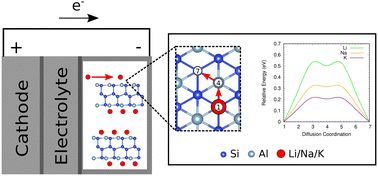Aluminum functionalized few-layer silicene as anode material for alkali metal ion batteries
Abstract
We have investigated the possibility of using aluminum functionalized silicene trilayers (ABC-Si4Al2) as an anode material for alkali metal ion batteries (AMIBs). First, we studied the thermodynamic stability of ABC-Si4Al2 using ab initio molecular dynamics simulations, showing that this material remains stable up to around 600 K. Then, we explored the properties of alkali metal atoms (Li, Na, K) adsorption in ABC-Si4Al2, finding several available sites with high average adsorption energies. Moreover, we computed the diffusion properties of those adsorbed atoms along high-symmetry paths using the nudged elastic band method. The results indicated diffusion barriers as low as the ones in graphite, especially for Na (0.32 eV) and K (0.22 eV), which allows those ions to migrate easily on the material's surface. Our studies also revealed that the full loaded Li4Si4Al2, Na2Si4Al2, and K2Si4Al2 systems provide low average open-circuit voltage, ranging from 0.14 to 0.49 V, and large theoretical capacity of 645 mAh g−1 for Li- and 322 mAh g−1 for Na- and K-ion batteries, values that are close to the ones in other anode materials, such as graphite, TiO2, and silicene-based systems. Those results indicate that aluminum functionalized few-layer silicene is a promising material for AMIBs anodes, particularly for Na- and K-ion batteries.

- This article is part of the themed collection: Celebrating Latin American Chemistry


 Please wait while we load your content...
Please wait while we load your content...